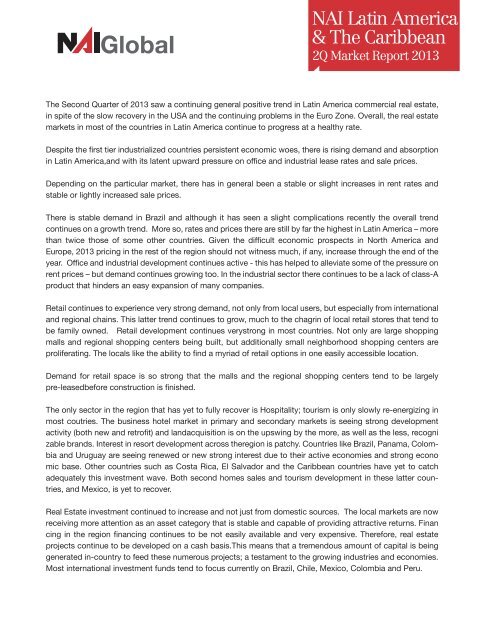2nd Q Market Report 2013 - NAI Mexico
2nd Q Market Report 2013 - NAI Mexico
2nd Q Market Report 2013 - NAI Mexico
Create successful ePaper yourself
Turn your PDF publications into a flip-book with our unique Google optimized e-Paper software.
Global<strong>NAI</strong> Latin America& The Caribbean2Q <strong>Market</strong> <strong>Report</strong> <strong>2013</strong>The Second Quarter of <strong>2013</strong> saw a continuing general positive trend in Latin America commercial real estate,in spite of the slow recovery in the USA and the continuing problems in the Euro Zone. Overall, the real estatemarkets in most of the countries in Latin America continue to progress at a healthy rate.Despite the first tier industrialized countries persistent economic woes, there is rising demand and absorptionin Latin America,and with its latent upward pressure on office and industrial lease rates and sale prices.Depending on the particular market, there has in general been a stable or slight increases in rent rates andstable or lightly increased sale prices.There is stable demand in Brazil and although it has seen a slight complications recently the overall trendcontinues on a growth trend. More so, rates and prices there are still by far the highest in Latin America – morethan twice those of some other countries. Given the difficult economic prospects in North America andEurope, <strong>2013</strong> pricing in the rest of the region should not witness much, if any, increase through the end of theyear. Office and industrial development continues active - this has helped to alleviate some of the pressure onrent prices – but demand continues growing too. In the industrial sector there continues to be a lack of class-Aproduct that hinders an easy expansion of many companies.Retail continues to experience very strong demand, not only from local users, but especially from internationaland regional chains. This latter trend continues to grow, much to the chagrin of local retail stores that tend tobe family owned. Retail development continues verystrong in most countries. Not only are large shoppingmalls and regional shopping centers being built, but additionally small neighborhood shopping centers areproliferating. The locals like the ability to find a myriad of retail options in one easily accessible location.Demand for retail space is so strong that the malls and the regional shopping centers tend to be largelypre-leasedbefore construction is finished.The only sector in the region that has yet to fully recover is Hospitality; tourism is only slowly re-energizing inmost coutries. The business hotel market in primary and secondary markets is seeing strong developmentactivity (both new and retrofit) and landacquisition is on the upswing by the more, as well as the less, recognizable brands. Interest in resort development across theregion is patchy. Countries like Brazil, Panama, Colombiaand Uruguay are seeing renewed or new strong interest due to their active economies and strong economic base. Other countries such as Costa Rica, El Salvador and the Caribbean countries have yet to catchadequately this investment wave. Both second homes sales and tourism development in these latter countries,and <strong>Mexico</strong>, is yet to recover.Real Estate investment continued to increase and not just from domestic sources. The local markets are nowreceiving more attention as an asset category that is stable and capable of providing attractive returns. Financing in the region financing continues to be not easily available and very expensive. Therefore, real estateprojects continue to be developed on a cash basis.This means that a tremendous amount of capital is beinggenerated in-country to feed these numerous projects; a testament to the growing industries and economies.Most international investment funds tend to focus currently on Brazil, Chile, <strong>Mexico</strong>, Colombia and Peru.


